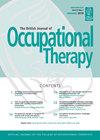The reliability and validity of the cone evasion walk test in patients with hip osteoarthritis
IF 1.3
4区 医学
Q3 REHABILITATION
引用次数: 0
Abstract
Background: Hip osteoarthritis (OA) can result in joint pain, stiffness, compromised balance, hindered mobility, and decreased functional independence. The Cone Evasion Walk Test (CEW) was designed for evaluating balance by evaluating the capacity to evade obstacles. Consequently, the study’s objective was to assess the validity and reliability of the CEW in hip OA patients. Methods: A total of 24 patients with hip OA were enrolled. Patients performed trials for the CEW and the timed up and go test (TUG). Between the trials, patients rested for an hour. The falls within the previous 12-month period were reported. Results: The analysis showed that the CEW has excellent reliability and high validity in hip OA. ( p < 0.001). The relative (intraclass correlation [ICC] coefficient) and absolute (SEM and SRD95) reliability of the CEW were 0.96 (0.88–0.98 95% CI), 0.56, and 1.54, respectively. The Spearman correlation coefficient between the CEW and the TUG was 0.74 ( p < 0.001) and between the CEW and the falls in the last 12 months was 0.51 ( p > 0.05). Conclusions: The CEW is effective for evaluating the function, dynamic balance, and mobility in patients with hip OA and could be a more accurate measure of the dynamic balance activities in the community.髋关节骨关节炎患者锥体逃避行走试验的信度和效度
背景:髋关节骨关节炎(OA)可导致关节疼痛、僵硬、平衡受损、活动受限和功能独立性下降。圆锥体回避行走测试(CEW)是一种通过评估躲避障碍物的能力来评估平衡能力的测试。因此,本研究的目的是评估CEW在髋关节OA患者中的有效性和可靠性。方法:共纳入24例髋关节OA患者。患者进行了CEW和计时起跑测试(TUG)的试验。在两次试验之间,患者休息一小时。报告了前12个月期间的下降。结果:分析表明CEW在髋关节OA诊断中具有良好的信度和较高的效度。(p & t;0.001)。CEW的相对(类内相关[ICC]系数)和绝对(SEM和SRD95)信度分别为0.96 (95% CI 0.88 ~ 0.98)、0.56和1.54。CEW与TUG的Spearman相关系数为0.74 (p <0.001),而在过去12个月中,道琼斯指数与下跌之间的差距为0.51 (p >0.05)。结论:CEW可有效评估髋关节骨性关节炎患者的功能、动态平衡和活动能力,可以更准确地衡量社区中髋部骨性关节炎患者的动态平衡活动。
本文章由计算机程序翻译,如有差异,请以英文原文为准。
求助全文
约1分钟内获得全文
求助全文
来源期刊

British Journal of Occupational Therapy
REHABILITATION-
CiteScore
2.20
自引率
15.40%
发文量
81
审稿时长
6-12 weeks
期刊介绍:
British Journal of Occupational Therapy (BJOT) is the official journal of the Royal College of Occupational Therapists. Its purpose is to publish articles with international relevance that advance knowledge in research, practice, education, and management in occupational therapy. It is a monthly peer reviewed publication that disseminates evidence on the effectiveness, benefit, and value of occupational therapy so that occupational therapists, service users, and key stakeholders can make informed decisions. BJOT publishes research articles, reviews, practice analyses, opinion pieces, editorials, letters to the editor and book reviews. It also regularly publishes special issues on topics relevant to occupational therapy.
 求助内容:
求助内容: 应助结果提醒方式:
应助结果提醒方式:


